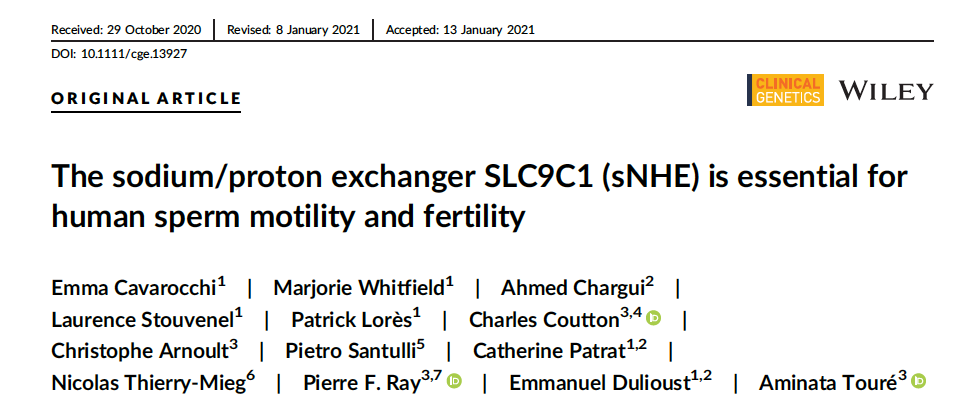2021 Publications - Focus on SLC9C1
The team has published 8 articles in 2021. Among our main achievements, PhD work from Emma Cavarocchi has led to the identification of mutations in SLC9C1 that are responsible for human functional asthenozoospermia. This work is novel by highlighting the signalling pathways activated by ion exchanges between sperm cells and the genital tract, and which are critical for sperm motility and fertilization potential.
Article abstract
Asthenozoospermia, defined by the absence or reduction of sperm motility, constitutes the most frequent cause of human male infertility. This pathological condition is caused by morphological and/or functional defects of the sperm flagellum, which preclude proper sperm progression. While in the last decade many causal genes were identified for asthenozoospermia associated with severe sperm flagellar defects, the causes of purely functional asthenozoospermia are still poorly defined. We describe here the case of an infertile man, displaying asthenozoospermia without major morphological flagellar anomalies and carrying a homozygous splicing mutation in SLC9C1 (sNHE), which we identified by whole-exome sequencing. SLC9C1 encodes a sperm-specific sodium/proton exchanger, which in mouse regulates pH homeostasis and interacts with the soluble adenylyl cyclase (sAC), a key regulator of the signalling pathways involved in sperm motility and capacitation. We demonstrate by means of RT-PCR, immunodetection and immunofluorescence assays on patient’s semen samples that the homozygous splicing mutation (c.2748 + 2 T > C) leads to in-frame exon skipping resulting in a deletion in the cyclic nucleotide-binding domain of the protein. Our work shows that in human, similar to mouse, SLC9C1 is required for sperm motility. Overall, we establish a homozygous truncating mutation in SLC9C1 as a novel cause of human asthenozoospermia and infertility.
Read the full article –> https://onlinelibrary.wiley.com/doi/10.1111/cge.13927
Clinical genetics 99, 684—693 (2021)
Asthenozoospermia, defined by the absence or reduction of sperm motility, constitutes the most frequent cause of human male infertility. This pathological condition is caused by morphological and/or functional defects of the sperm flagellum, which preclude proper sperm progression. While in the last decade many causal genes were identified for asthenozoospermia associated with severe sperm flagellar defects, the causes of purely functional asthenozoospermia are still poorly defined. We describe here the case of an infertile man, displaying asthenozoospermia without major morphological flagellar anomalies and carrying a homozygous splicing mutation in SLC9C1 (sNHE), which we identified by whole-exome sequencing. SLC9C1 encodes a sperm-specific sodium/proton exchanger, which in mouse regulates pH homeostasis and interacts with the soluble adenylyl cyclase (sAC), a key regulator of the signalling pathways involved in sperm motility and capacitation. We demonstrate by means of RT-PCR, immunodetection and immunofluorescence assays on patient’s semen samples that the homozygous splicing mutation (c.2748 + 2 T > C) leads to in-frame exon skipping resulting in a deletion in the cyclic nucleotide-binding domain of the protein. Our work shows that in human, similar to mouse, SLC9C1 is required for sperm motility. Overall, we establish a homozygous truncating mutation in SLC9C1 as a novel cause of human asthenozoospermia and infertility.
